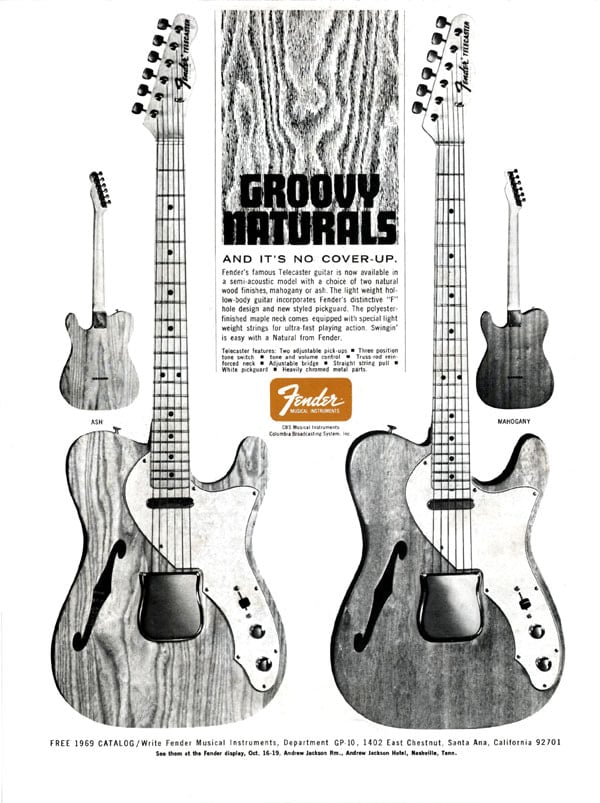Telecaster Pre-CBS & CBS: new models
Telecaster Custom, Telecaster Thinline and Telecaster Deluxe


|
In addition to announcing the Telecaster and Esquire with the new rosewood fingerboard, the 1959 Summer NAMM saw the debut of the Telecaster Custom and Esquire Custom, as high-end alternatives to standard models, featuring an alder body with a three-tone sunburst finish, white binding on the front and rear edges of the body, and three-layer white celluloid pickguard. Because of its unstable nature, celluloid had the characteristic of turning brown over time, especially if subjected to light or smoke. So, these pickguards were never completely white, but showed a greenish-yellow hue, hence the name of mint green pickguards.
Forrest White in his book stated that the first Telecasters with binding actually dated back to 1958 and were built with the help of Fred Martin: “Fred Martin, of the Martin Guitar Company, had been kind enough to show me through his factory. He showed me the special tool they made to cut binding strips, and what material and what adhesive to use. One Telecaster was for Buck Owens, one for his guitarist, Don Rich, and one was a spare. A matching Precision Bass was also made.” |
|
Towards the end of the 1960s rock music became harder and harder, enhancing the sustain and sound of Gibson's humbucking pickups. For this reason, CBS, owner of the Fender brand, began to feel the need to use these pickups also for Fender instruments, which had always been associated with the sound of single coils. In 1967 Richard Dick Evans, a former Gibson employee who worked at Fender at that time, invited Seth Lover, a recently resigned humbucker inventor from Gibson, to visit the Fullerton factory. Shortly thereafter, Seth was hired by Fender and designed the Fender Wide Range Humbucking Pickup, the first Fender humbucker. This pickup featured twelve threaded magnetic poles made of CuNiFe, an alloy based on copper, nickel and iron. Once the metal cover was soldered, only six pole pieces, split in two offset rows, came out of the cover and could be adjusted in height: those of E, A and D of the coil closest to the neck and those of G, B and high E of the coil closest to the bridge. The other poles were upside down and were hidden by the cover.
|
 Philip Kubicki
Philip Kubicki
|
Certainly, after the sale to CBS, Fender tried to figure out which solid-body model could be converted into a hollow-body. Obviously, the Stratocaster could not be taken into consideration because the body had too many curves, so the choice fell on the Telecaster.
Already in 1966, a guitar had been built, never going into production, which had a Telecaster hollow and double-bound body, the neck of the Jazzmaster and the vibrato of the Mustang. At the beginning of 1967, Roger Rossmeisl and Virgilio Simoni built a first prototype. The instrument, which never went into production, had a completely hollow body, with the top in spruce and the bottom in zebrano. In 1967, to lighten the Telecaster's heavy ash body, some “Smuggler's Tellies” were made whose bodies featured small cavities hidden under the pickguard, but they were not very successful. |

|
© COPYRIGHT 2014-2024 FUZZFACED.NET BY ANTONIO CALVOSA - TUTTI I DIRITTI RISERVATI
La copia, la riproduzione, la pubblicazione e la redistribuzione dei contenuti, se non autorizzate espressamente dall'autore, sono vietate in qualsiasi modo o forma. |

|
© COPYRIGHT 2014-2024 FUZZFACED.NET BY ANTONIO CALVOSA - ALL RIGHTS RESERVED
The copying, reproduction, publication and redistribution of the contents, unless expressly authorized by the author, are prohibited in any way or form. |